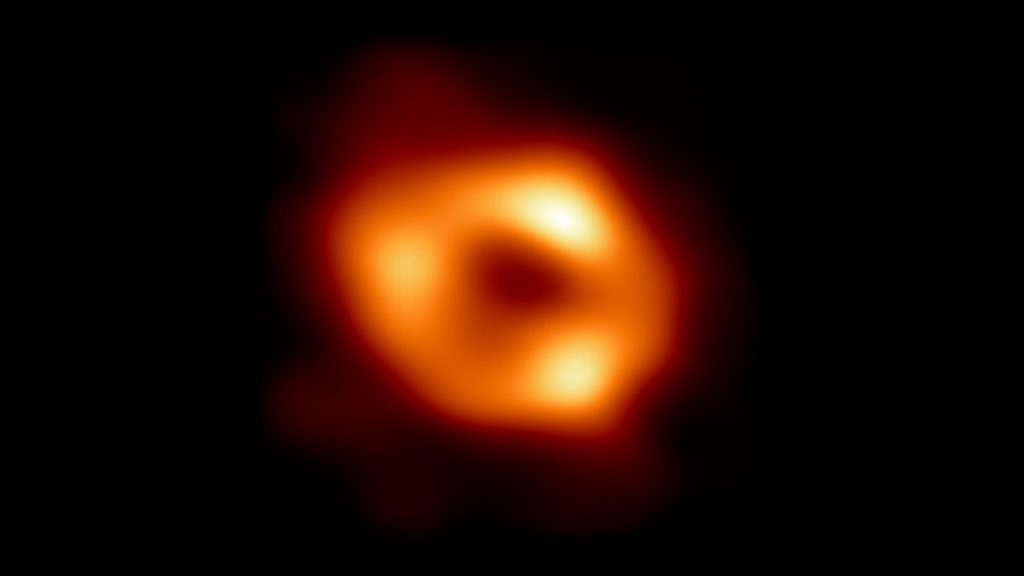Astronomers needed a telescope the size of Earth to image the monster black hole at the center of the Milky Way — and next time they tackle the continuing observations, they’ll have help from NASA’s next-generation observatory in space.
The James Webb Space Telescope, also known as JWST or Webb, launched in December 2021 and is wrapping up preparations to begin observing the universe. Among the tasks scheduled for the new observatory’s first year of work is teaming up with the Event Horizon Telescope (EHT), the global array of observatories that published the first-ever photo of a black hole in April 2019.
The EHT repeated the feat in May, when it released the first image of Sagittarius A*, the supermassive black hole at the center of our Milky Way galaxy, in May, revealing a lumpy, blurry, golden ring on a black background.
Live updates: NASA’s James Webb Space Telescope mission
Related: How the James Webb Space Telescope works in pictures
One of the countless scientists waiting to see that image was Farhad Yusef-Zadeh, an astronomer at Northwestern University in Illinois. He was particularly invested in the EHT’s work on Sagittarius A* because, earlier this year, he was awarded precious time on JWST to observe the monster black hole.
The picture didn’t disappoint. “It was a nice surprise,” he told Space.com.
“I thought that the image would be a little bit more messy because of the variability of Sagittarius A*,” he said. “It looks pretty good, for sure — for a first image.”
Sagittarius A* is a tricky object to study because — in addition to all the usual constraints of a black hole — spots along its event horizon suddenly shoot out particles at nearly the speed of light. (A black hole’s event horizon is the point beyond which nothing, not even light, can escape.) These flares can occur four or five times a day, making Sagittarius A* a particularly changeable beast.
“These hotspots basically all of a sudden turn on and flare,” Yusef-Zadeh said. “It’s like a firework, essentially, and it lasts for about half an hour or so. Sometimes they come together; you have multiple fireworks, simultaneously or one after the other.”
But the mechanics of the flares themselves are a mystery.
“We still don’t know how flares are produced,” Yusef-Zadeh said. “Flares are particles like cosmic ray particles that are moving close to the speed of light. Something must have really accelerated them to go to close to the speed of light, and we still don’t know what it is.”
Each flare is first visible in infrared light, but over time the signal stretches into what astronomers call submillimeter radiation. And coincidentally, it’s submillimeter radiation that the Event Horizon Telescope gathers to make its black hole images — which means that EHT scientists are detecting the signal of the underlying black hole and that of the flare.
“This is the worst thing that can happen to imaging a black hole, because you don’t want to observe a variable source,” Yusef-Zadeh said. “You need to take out the variable component to really construct a proper image of the source itself.”
That’s where Webb comes in.
JWST brings several strengths to the collaboration. Orbiting a point nearly 1 million miles (1.5 million kilometers) from Earth, there’s no cloudy weather to interfere with observations. And the distant vantage point, along with the observatory’s massive sunshield, keep its instruments cold enough to study infrared light. Moreover, Webb boasts two instruments that can simultaneously gather data in two different types of infrared light.
“Having the ability to simultaneously observe the flaring events at near-infrared and mid-infrared as far as I know has never been done before,” Yusef-Zadeh said. The continuous observations at both wavelengths should allow scientists to distinguish between Sagittarius A* and its flares. “It’s like two telescopes, basically, observing simultaneously.”
(NASA’s venerable Hubble Space Telescope has studied Sagittarius A* in infrared. But Hubble can only monitor one wavelength at a time, and it observes in chunks just 45 minutes long as it passes between day and night in Earth’s orbit.)
Because of the partnership with the EHT, Yusef-Zadeh’s team is subject to the scheduling constraints of the program, which typically conducts its observations over about a week in March or April to aim for the most promising weather. Next spring’s campaign is tentatively scheduled for April 2023, he said, when JWST will spend 25 hours studying the supermassive black hole.
Independently of the EHT observations, Yusef-Zadeh said that he expects the Webb observations of flares to teach scientists plenty about how these features work.
But will Sagittarius A* flare while Webb is watching it? Yusef-Zadeh thinks the odds favor his team. “I have a feeling having two days is good, and if it doesn’t work out, you come back the following year,” he said. “We’ll try again; it’s not a one-shot deal.”
And even if JWST can’t catch a flare, the observations will still be valuable, he emphasized, given the partnership with the Event Horizon Telescope. “Some people really may like it not to have any flares — that means that the imaging is going to be quite good, then it’s not interfering at all with the EHT imaging,” he said.
Ultimately, he said, he’ll take whatever observations he gets. “It’s a black hole. It can do whatever it wants.”
Email Meghan Bartels at mbartels@space.com or follow her on Twitter @meghanbartels. Follow us on Twitter @Spacedotcom and on Facebook.

